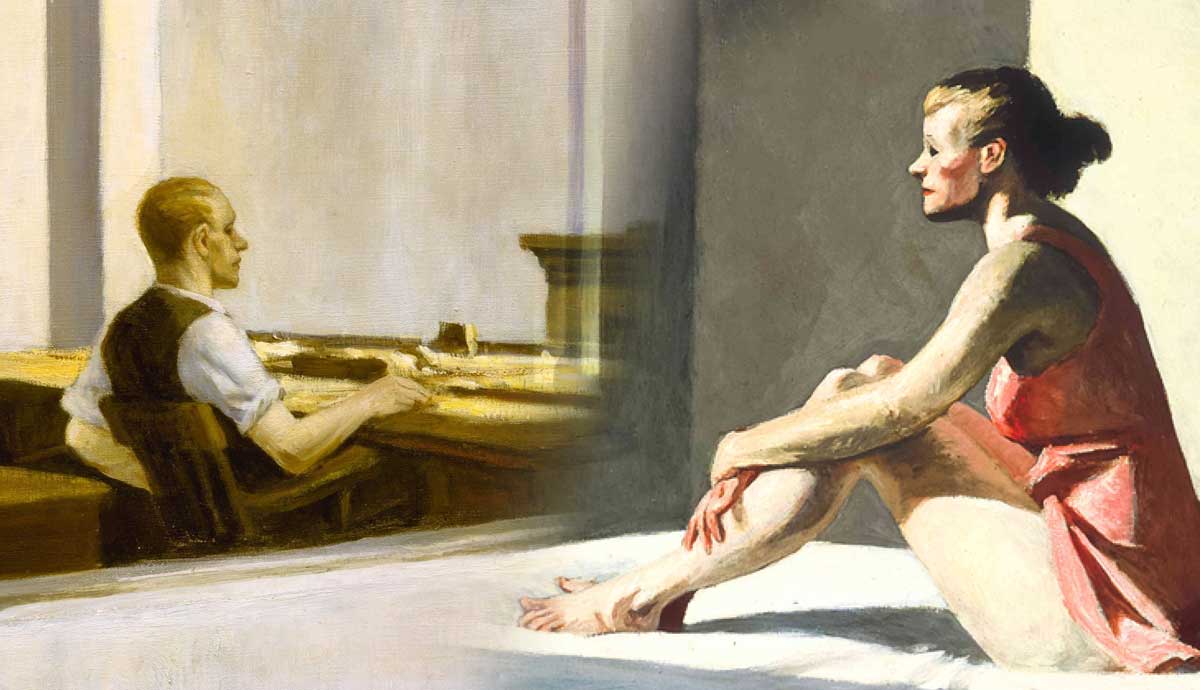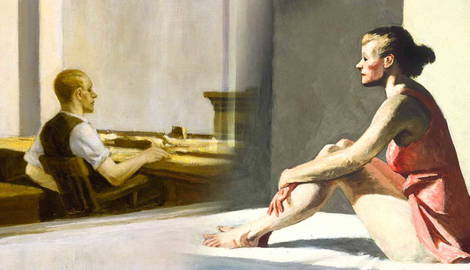
It is not a novel suggestion to associate American realist painter Edward Hopper with urban loneliness. In fact, Hopper protested that those who talked about his paintings overdid “the loneliness thing.” Hopper’s realism has been described as one that haunts, is minimalist, isolated, and differential, defined by what it leaves out rather than what it shows. Hopper’s paintings feature spaces–urban exteriors and interiors–that are geometric in their architecture and stone-cold in their apparently stripped-down simplicity. Nevertheless, he imbues these spaces with an uncanny emotionality that reflects complexity, evokes an inanition, and elicits poignancy.
Hopper’s Poetics of the Inner Life

Influenced by Edgar Degas and Robert Henri’s unsentimental depiction of a diverse New York City, Hopper prioritized the inner life of the artist as opposed to the external manifestation of the human condition. The details in his paintings, or the lack thereof, nudge the audience to impose meaning on the picture, attribute a storyline to the framework provided by him, and surmise a narrative, thereby creating a space in which the inner life of the artist and the viewer could intermingle. The reflections of our own selves merge with that of the artist, birthing a pathos of an “other,” of someone who is neither us nor the artist, someone we do not understand but can only attempt to. This distancing leads to a forlornness that the audience does not anticipate before they walk into the gallery, and that perplexes them even after they have left.

Hopper himself led a life of solitude, haunted by the terrors of war and marital turbulence. When we think of Edward Hopper’s paintings, we think of disconnect. We think of figures in isolation, people and places positioned at a distance (from the artist and the audience), and silent howls of loneliness.
Hopper’s paintings scream desolation, but how is this desolation executed? The subject is solitary, surely, but the landscape, the brush strokes, the colors, the blocking, the light, and the interplay of all these elements creates an ambiance that lets the audience enter the frame with a perspective of their own.
The paintings of Hopper thus accommodate this “other” sentiment, which becomes alienated from the painter and the audience. Looking at Hopper’s paintings hence becomes a reading that generates the pathos of the “other,” contemplates the humanity that’s trapped inside the frame of realism, and becomes a study of “the loneliness thing”.
Nighthawks: Who Is the Lonely One Here?

Edward Hopper’s paintings reflect the vacuity of human life and suffering in general and the listlessness of human existence by holding up a mirror to society. At first glance, Nighthawks depicts a small assortment of rather lonely individuals. What is intriguing, however, is the perspective: the viewer realizes that the loneliest thing in this context is indeed themselves, standing outside the bar, in the dark, staring at strangers from across the street.
The surface of the painting is a screen that directs the view toward what the artist has placed at a distance from the spectator. The painting, therefore, becomes a screen that, in a mirror-like manner, becomes a placeless place that, according to Michel Foucault,
“… enables me to see myself there where I am absent,” and yet from the standpoint of which “I discover my absence from the place where I am since I see myself over there. Starting from this gaze that is, as it were, directed toward me, from the ground of this virtual space that is on the other side of the glass, I come back toward myself; I begin again to direct my eyes toward myself and to reconstitute myself there where I am.”

The nuances of spatiality are presented by interpreting the paintings as a kind of mirror, glass, or reflection (in addition to the surface of the painting being regarded as a screen or mirror itself). Also, the paintings often trick the eye, as in Office in a Small City: is the glass even there? The “other,” this resonating soul of the audience and the artist, remains confined in these uncertain spatial gaps between the various presences in the paintings, often betraying itself in the different evidence of life throughout, as in the slanting streaks of light.
Hopper’s Paintings: The Reflection & the Reflecting Surface

Hopper’s portrayal of figures or anatomy in his paintings is uncannily non-sexualized. It is almost a desolate desexualization (one may even call it intentional). Even in paintings where the human body (female) is bared or barely covered in slips, the gaze is never sexual nor sensual.
In this regard, let’s look at A Woman in the Sun, pictured below. The blunt brush strokes, the ingress of sunlight, and the cool tones smooth out the picture and ascribe it objectivity, despite it seemingly being a private space. The shadow lines enhance the human, not the woman. The blues and greens contrasted with the undispersed yellow of the sunlight create an expressive strength that is simple yet effective. Everything about her face, limbs, and the cigarette hanging from her fingers paints this portrait of a woman in the embrace of an extreme emptiness.

It is as if the bodies remain on the canvas, as discordant raw materials, elements employed to create or construct a piece, but the soul hovers. A dismemberment occurs, giving the audience the agency and the liberty to re-member the elements together. The viewer connects the signs of life throughout the picture, gaining access to the interior world of the artist while at the same time freeing their own. The painting becomes a reflection and a reflecting surface simultaneously.
The loneliness thing, despite being disdained by the artist himself, gains momentum through audience participation, whose perception the artist cannot control but can only direct. The interiority of the artist and the audience coalesce, and the souls fuse, resulting in resonating screams of quiet desolation.
The “Other”: The Confined Soul

It is the soul, thus, that is lonely. The figures Hopper paints are not always alone: in fact, more often than not, Hopper paints a non-alone figure; certain paintings even feature a social gathering. It becomes exceedingly clear even then that his paintings do not spoon-feed the idea of loneliness but rather reflect loneliness in an unrelentingly striking manner.

Painted in 1914, Soir Bleu is unsettling, to say the least (the clown’s presence is especially a subject of discussion). The entire composition is influenced by French impressionists, albeit the style is not inherently impressionistic. In fact, Hopper is said to have disdained style completely while just printing out copies of reality. The piece is not inherently one of isolation, but upon a close reading, one notices the stillness.
Firstly, the class barriers are not elusive: there is an indiscreetly dressed woman, a clown, artists, and a man dressed in a tuxedo. Secondly, no one is conversing with another, apart from the second and third man (and even then, one surmises that they are engaged in dialogue just by observing the head placement of the third man). The person on the extreme left has his lips open as if in the middle of uttering something, but it may very well be only to accommodate his cigarette.
The figures in the painting tell only one story: the story of absences. What becomes important is not what Hopper has kept in but what he has left out. What is the man on the left doing? Is he talking to someone? Who is he talking to? Why is no one looking at each other? The characters who do inhabit the landscape of the painting seem to be waiting for the answers as well.
The Endless Wait

In contextualizing Hopper’s paintings, one discovers that Edward Hopper becomes a manifesto of hope. How? Our inner and outer lives are in disarray; often, one finds no screen between the two. Our minds are the spaces of Hopper’s paintings-desolate, empty yet sunlit. We are in the middle of an incessant wait, suspended in liminality, awaiting meaning, just as Hopper’s paintings await narrative. And just as Hopper’s paintings gain narrative via audience synergy and human collaboration, one hopes meaning will one day dawn upon us and existence will make sense, only in accordance with humanity. Thus, despite presenting the extreme loneliness of urban life, Edward Hopper represents, urges, and even precipitates solidarity and concord.










